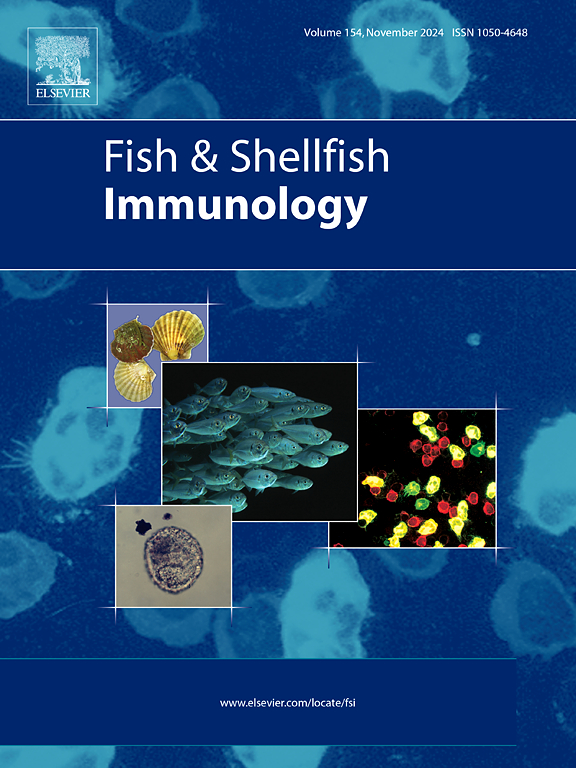神经肽F与其受体相互作用,调控日本血吸虫的免疫应答
IF 3.9
2区 农林科学
Q1 FISHERIES
引用次数: 0
摘要
在哺乳动物中,神经肽Y (NPY)在调节宿主免疫应答中发挥着重要作用。然而,无脊椎动物神经肽F (NPF)作为NPY的同源基因,其免疫调节功能的研究很少。在本研究中,NPF和NPFR (NPFR) mrna在患病的日本血吸虫和幼年的日本血吸虫沐浴感染哈维弧菌后显著上调。随后,分离粳稻血细胞,脂多糖(LPS)刺激后,粳稻血细胞中明显诱导出Sj_NPF和Sj_NPFR mrna。流式细胞术和拉下实验证实Sj_NPFR与Sj_NPFR之间存在相互作用。敲低NPF显著降低粳稻白体NPFR、一氧化氮合酶(NOS)、toll样受体(TLR)和白细胞介素-17-7 (IL-17-7) mRNA的表达。此外,体内注射NPF成熟肽后,粳稻白体中NPFR、NOS、TLR、TNF和IL-17-7 mrna均显著上调,粳稻肝脏中TNF和IL-17-7 mrna也有显著诱导作用。有趣的是,体内注射NPF成熟肽后,粳稻鳃中NPFR、TLR、MyD88和IL-17-7 mrna显著降低。最后,通过原位杂交(WISH)技术观察了Sj_NPF和Sj_NOS mrna在幼年墨鱼背部区域的共定位,体内注射NPF成熟肽后,肝脏内NO含量在24 h和48 h均有所增加。总之,这些结果揭示了Sj_NPF可能与其受体相互作用并介导免疫反应以消除入侵病原体。本文章由计算机程序翻译,如有差异,请以英文原文为准。

Neuropeptide F interacts with its receptor and regulates the immune response of Sepiella japonica
In mammals, neuropeptide Y (NPY) has been recognized for its role in modulating the immune response of host. However, invertebrate neuropeptide F (NPF), as a homologous gene of NPY, has been minimally explored immunomodulatory function. In this study, NPF and NPF receptor (NPFR) mRNAs were significantly up-regulated in sick Sepiella japonica, and in juvenile S. japonica after bath infection of Vibrio harveyi. Subsequently, hemocytes of S. japonica were isolated, and Sj_NPF and Sj_NPFR mRNAs were notably induced in the hemocyte of S. japonica after Lipopolysaccharide (LPS) stimulation. Flow cytometry and pull-down assay confirmed the interaction between Sj_NPF and Sj_NPFR. Afterwards, knockdown of NPF notably decreased the mRNA expression of NPFR, Nitric oxide synthase (NOS), Toll-like receptor (TLR) and Interleukin-17-7 (IL-17-7) in the white body of S. japonica. Furthermore, after in vivo injection of NPF mature peptide, NPFR, NOS, TLR, TNF and IL-17-7 mRNAs were significantly up-regulated in the white body of S. japonica, with TNF and IL-17-7 mRNAs also showing significant induction in the liver of S. japonica. Interestingly, NPFR, TLR, MyD88 and IL-17-7 mRNAs were significantly decreased in the gill of S. japonica after in vivo injection of NPF mature peptide. Finally, the colocalization of Sj_NPF and Sj_NOS mRNAs was observed in the dorsal area of juvenile cuttlefish using whole-mount in situ hybridization (WISH), and NO content was increased at 24 h and 48 h in the liver after in vivo injection of NPF mature peptide. Collectively, these results uncover that the Sj_NPF may interact with its receptor and mediate immune response to eliminate invasive pathogens.
求助全文
通过发布文献求助,成功后即可免费获取论文全文。
去求助
来源期刊

Fish & shellfish immunology
农林科学-海洋与淡水生物学
CiteScore
7.50
自引率
19.10%
发文量
750
审稿时长
68 days
期刊介绍:
Fish and Shellfish Immunology rapidly publishes high-quality, peer-refereed contributions in the expanding fields of fish and shellfish immunology. It presents studies on the basic mechanisms of both the specific and non-specific defense systems, the cells, tissues, and humoral factors involved, their dependence on environmental and intrinsic factors, response to pathogens, response to vaccination, and applied studies on the development of specific vaccines for use in the aquaculture industry.
 求助内容:
求助内容: 应助结果提醒方式:
应助结果提醒方式:


